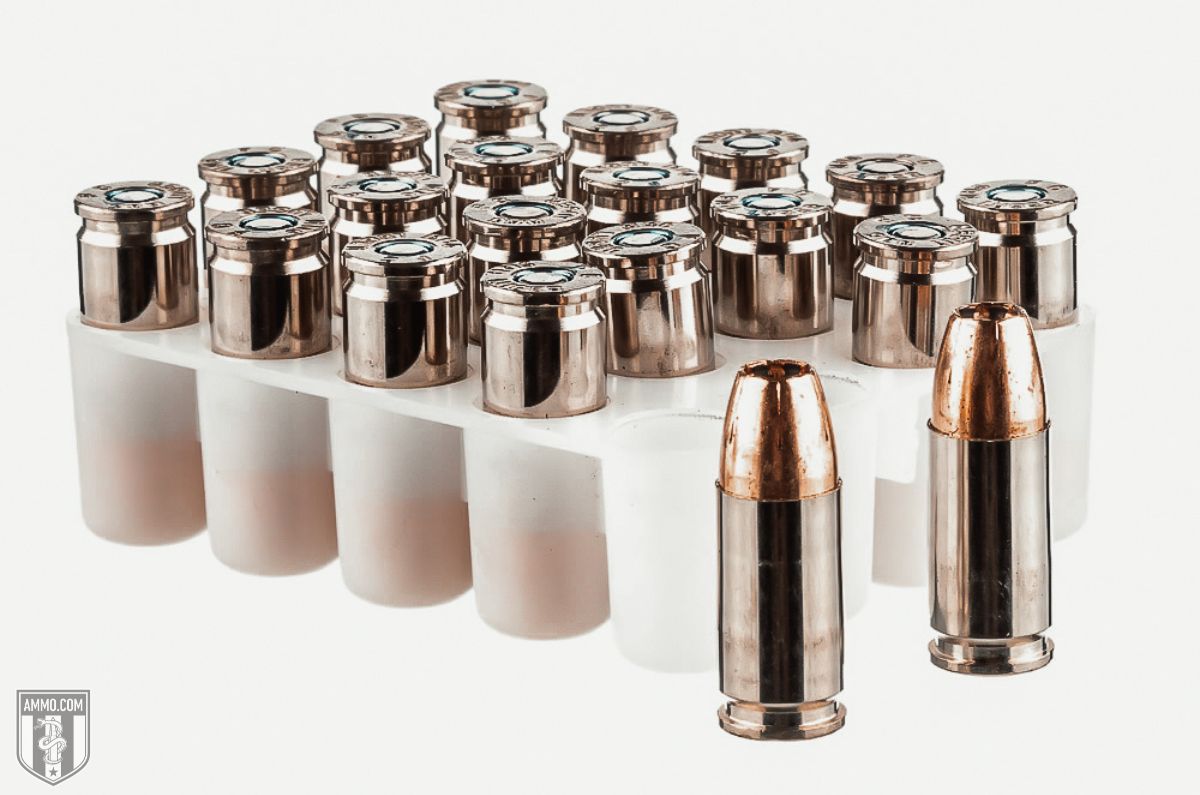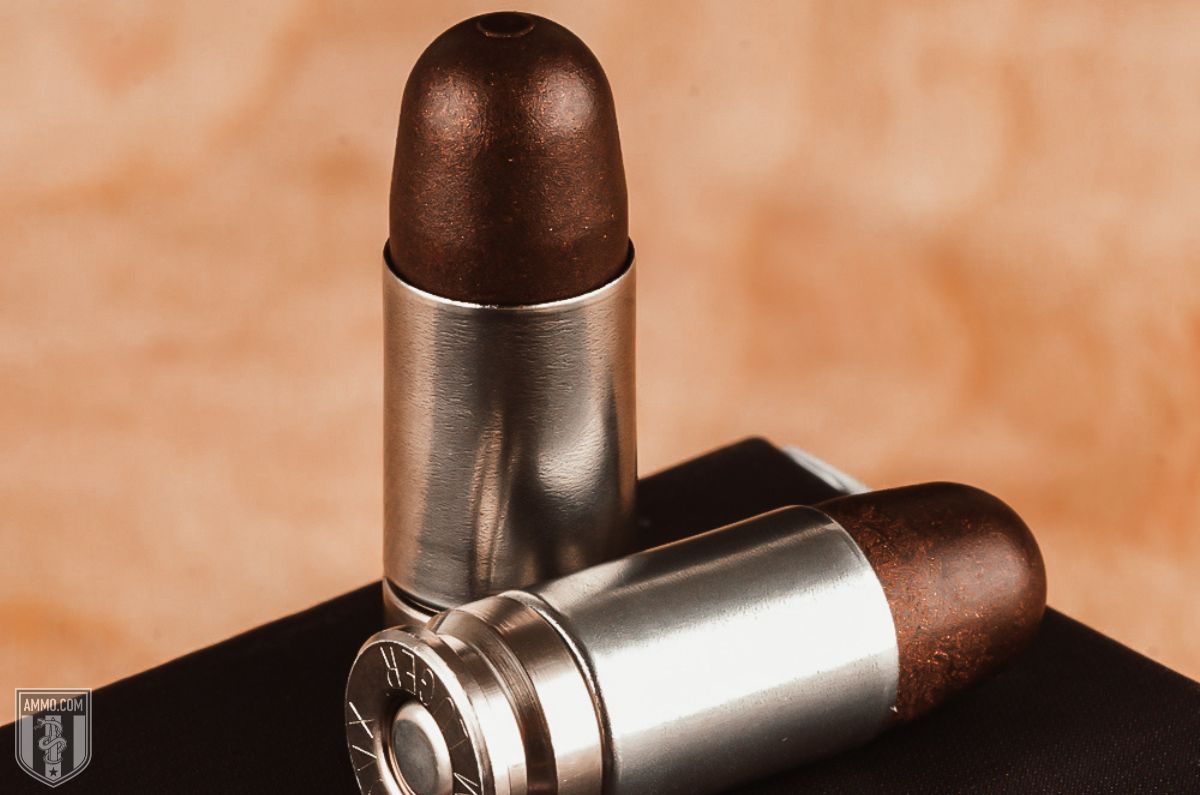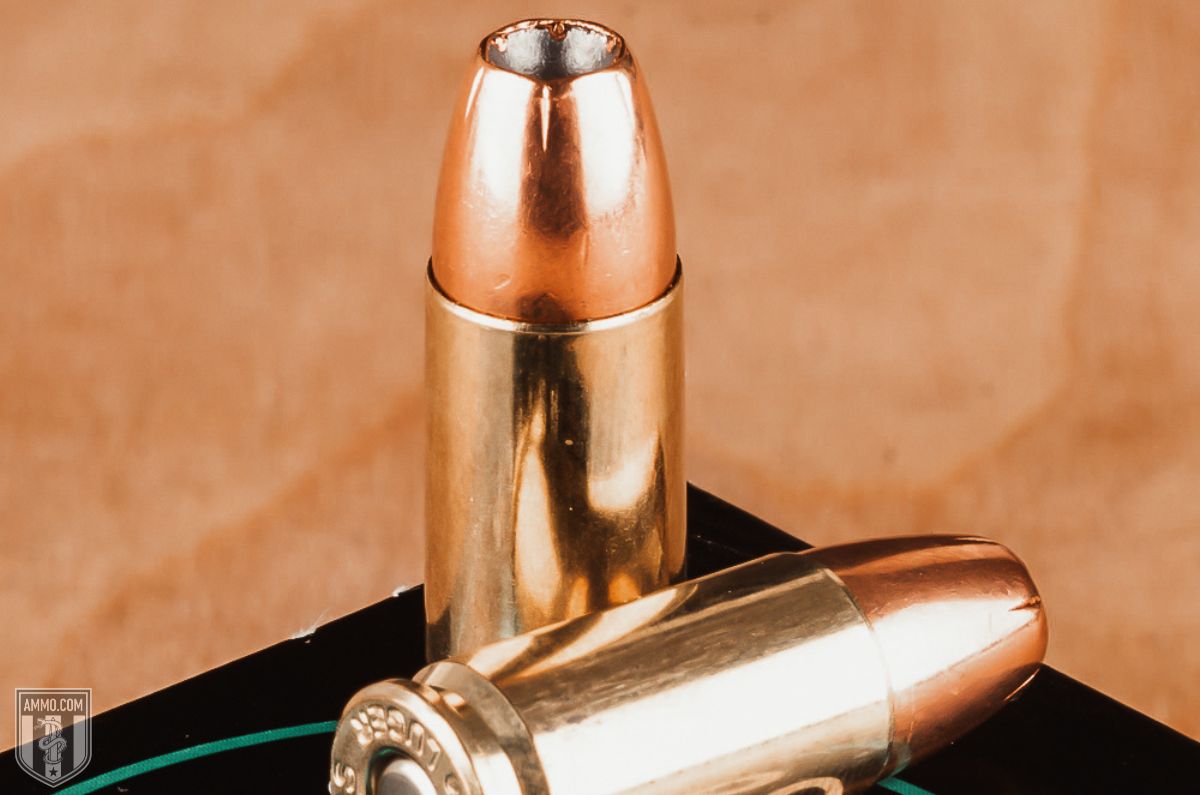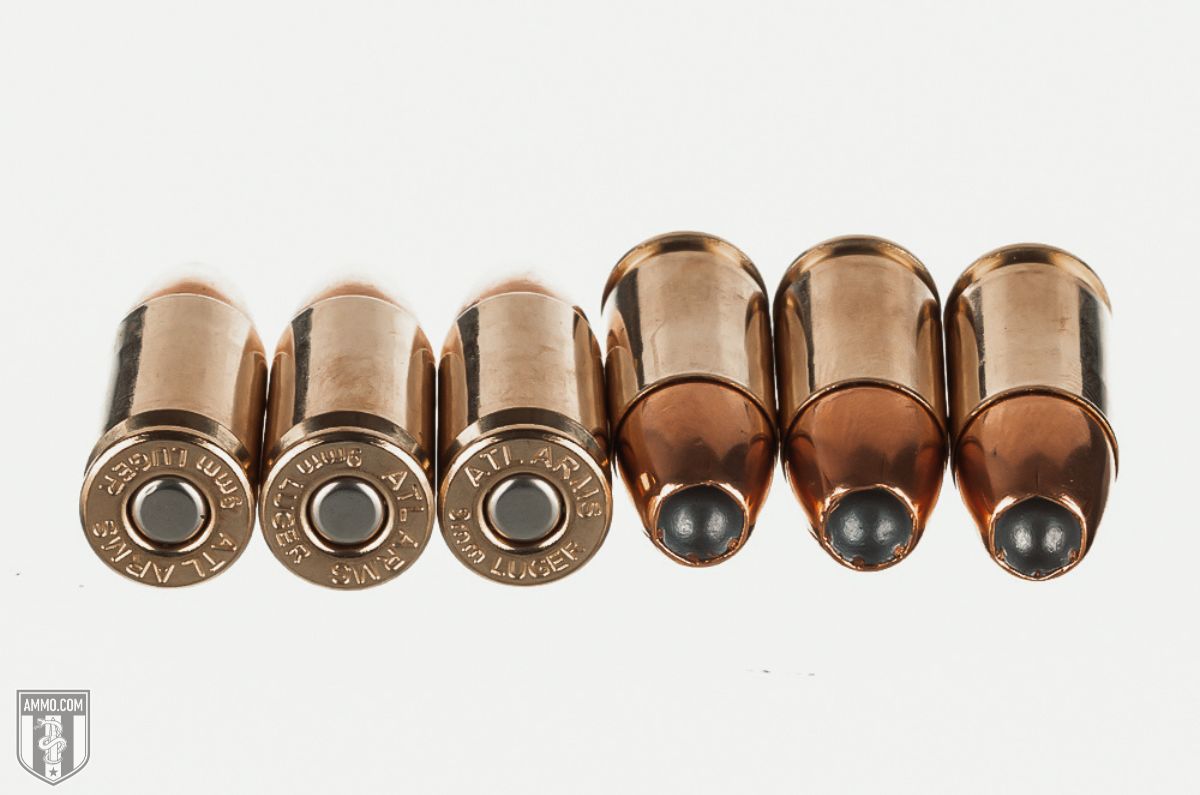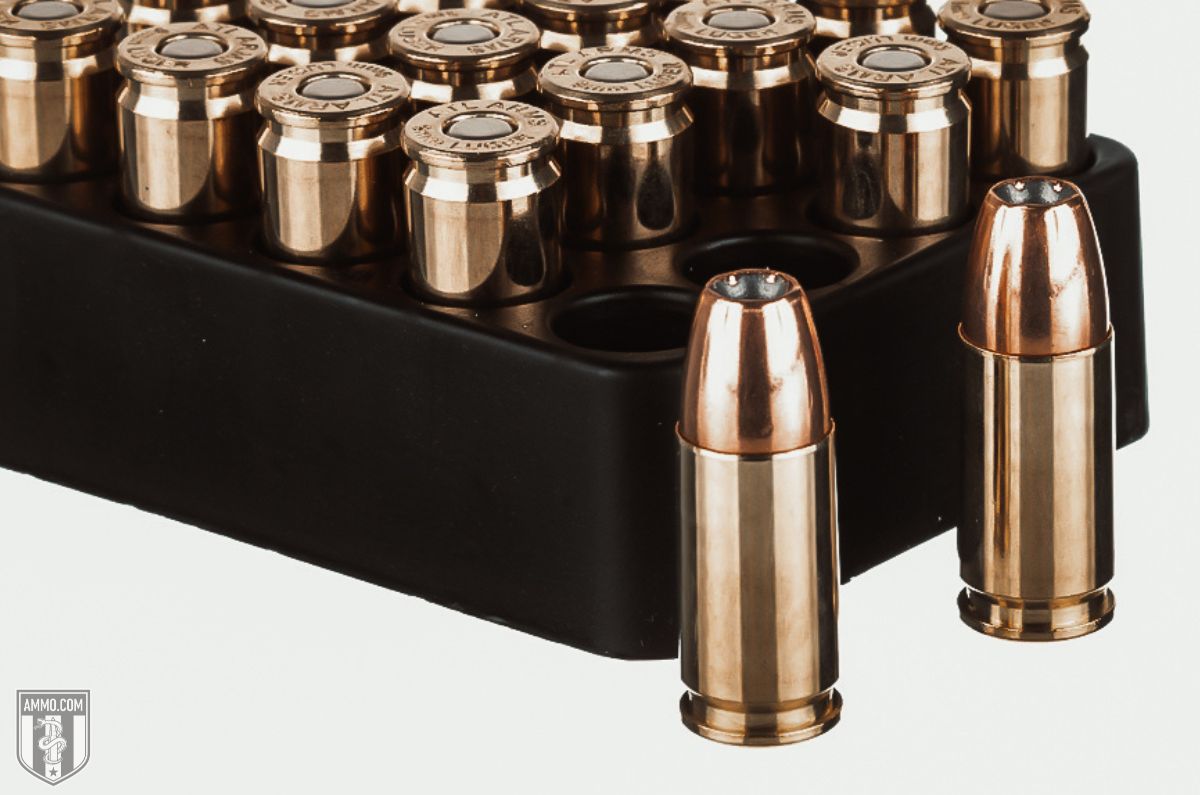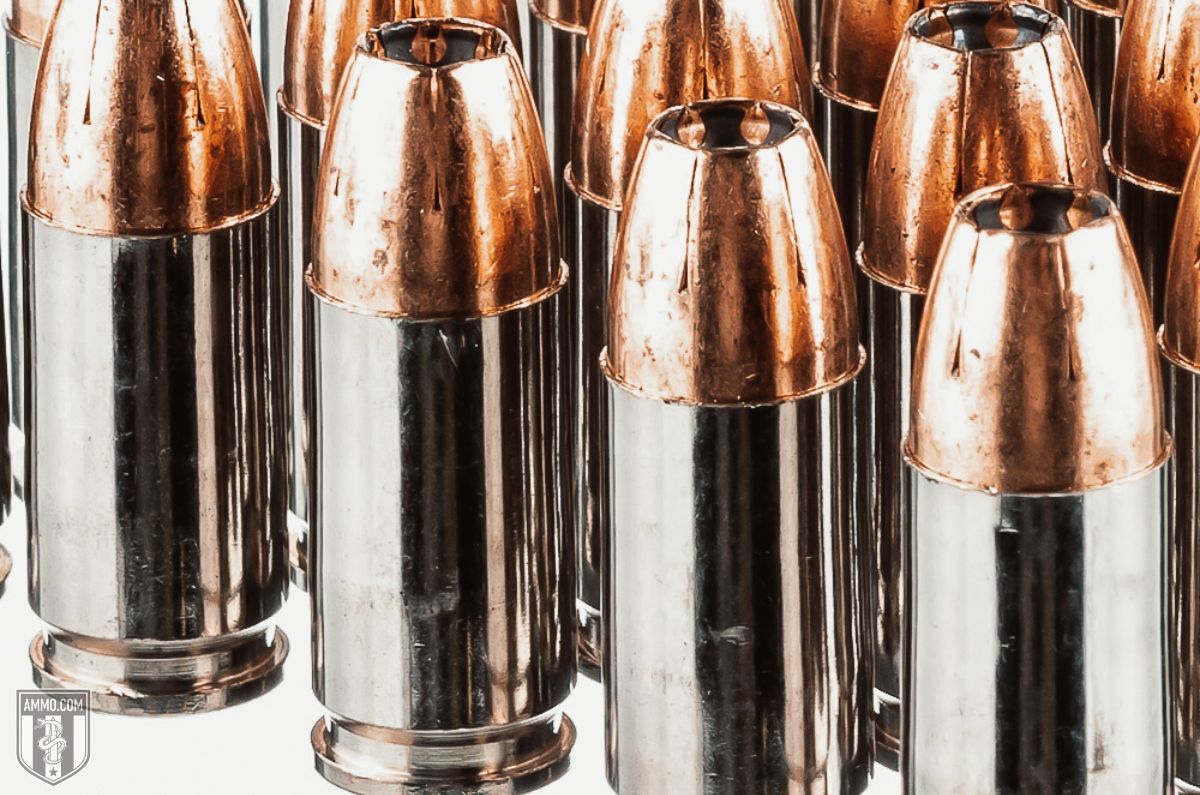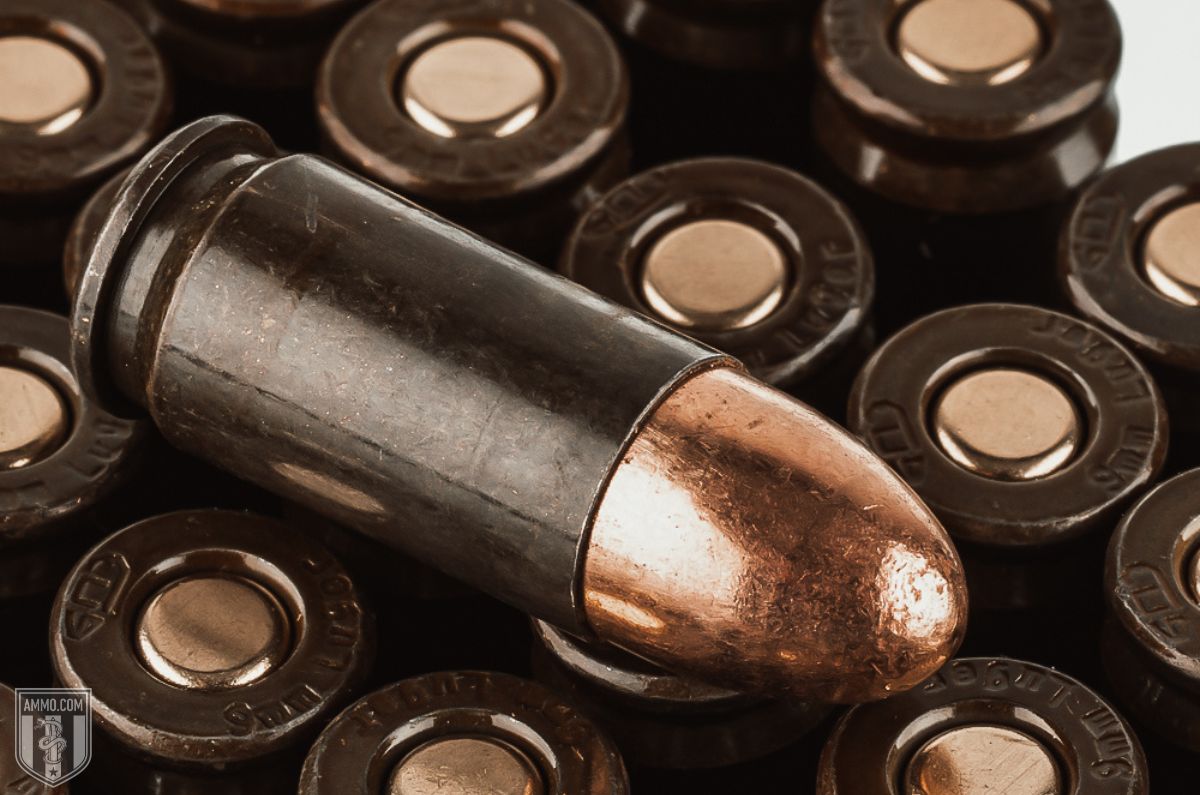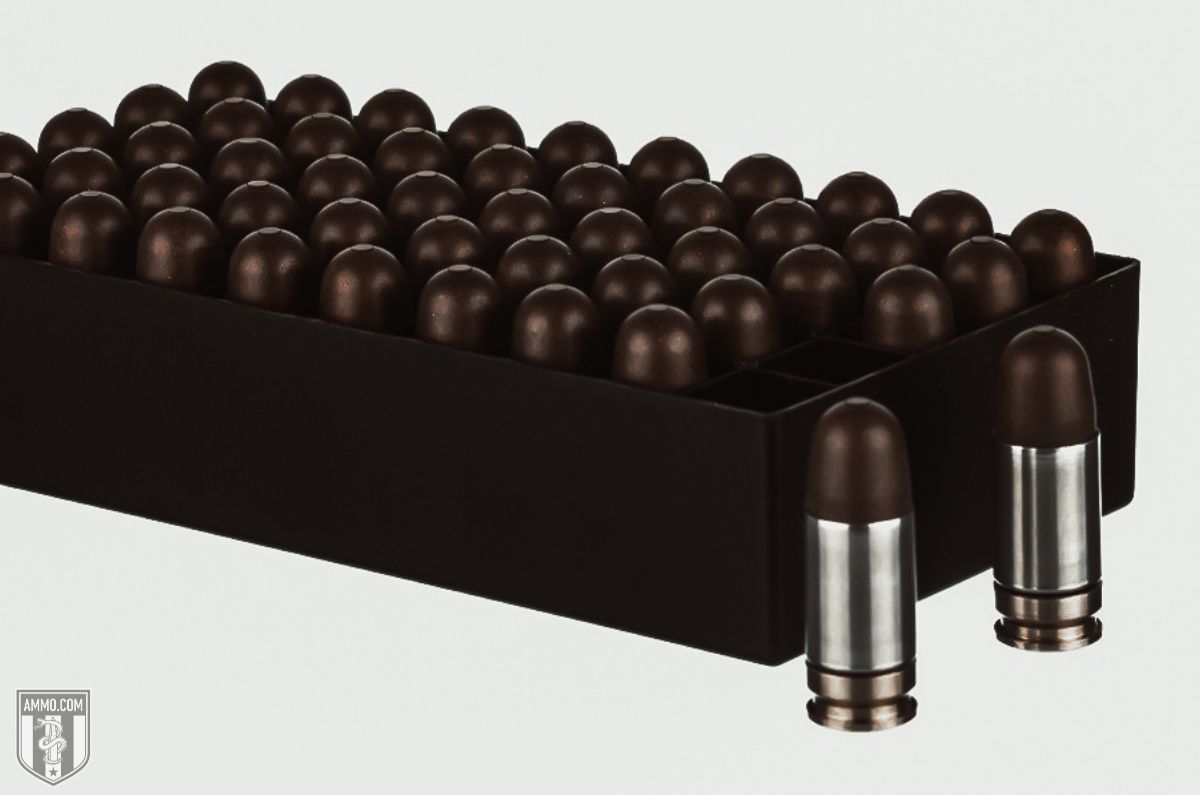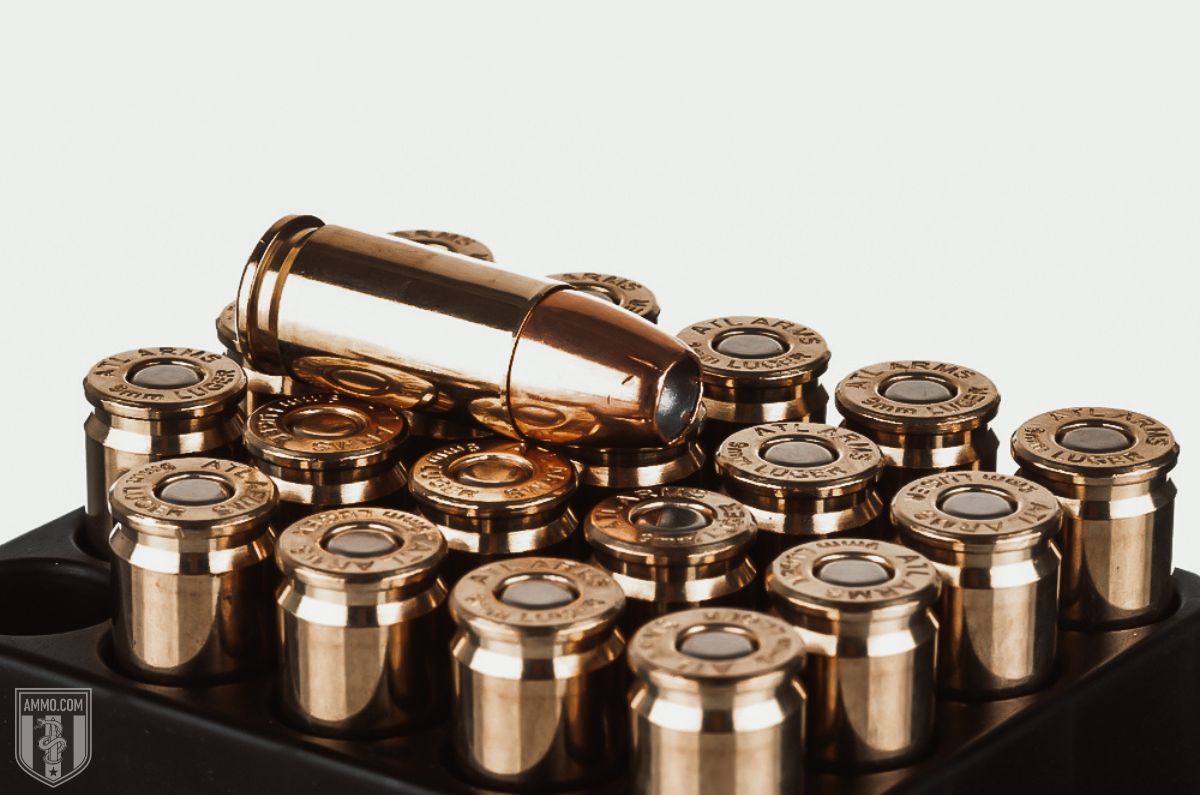9mm Makarov vs 9mm Luger: The 9mm Cartridge Cold War
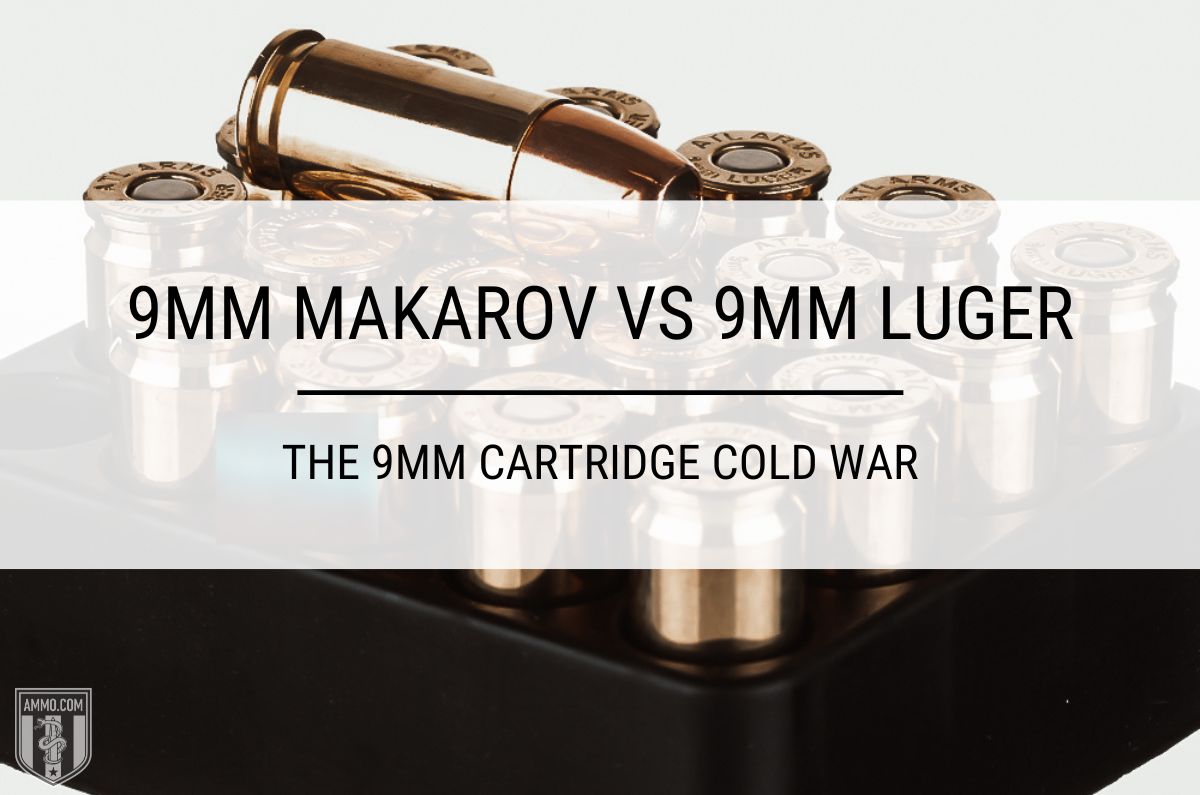
When it comes to East vs West pistol cartridges, it’s hard to ignore comparing the 9x19mm Luger and 9x18mm Makarov. Each round found itself on the opposite side of the Iron Curtain in the Cold War during the latter half of the 20th Century, with the Luger being on the side of NATO and the Makarov being the handgun cartridge choice of the Soviet Union.
Although these two 9mm rounds might look incredibly similar when you stand them side-by-side, the 9mm Luger is superior to the 9mm Makarov in all ballistic categories.
The ballistic superiority of the Luger cartridge causes some new shooters to wonder if the 9mm Makarov round is obsolete or if the round has some redeeming qualities? Is it worth it to pick up a Makarov pistol or should you just stick with a run of the mill 9mm NATO?
In this article, we will evaluate the 9x18 vs 9x19 to help you understand the differences between the two and give you a clearer understanding of which cartridge is best for your shooting needs.
What’s the difference between 9mm Makarov and 9mm Luger?
The difference between 9mm Makarov and 9mm Luger is that the 9mm Luger has a higher case capacity and is superior to the Makarov round in all ballistic categories. Furthermore, the 9x18mm Makarov typically fires lighter 95 grain bullets that have a slightly larger diameter compared to the heavier 115-147 grain bullets fired by the 9mm NATO.
Cartridge Specs
When evaluating centerfire cartridges, it’s a good idea to analyze the cartridge specs to gain more knowledge of each.
The 9x19mm Luger is the most popular centerfire submachine gun and pistol cartridge in the world and was developed in 1901 by Georg Luger. Luger used his previous design, the 7.62x21mm Parabellum as the parent case for his new creation.
The 9mm Luger is the official name for the cartridge per SAAMI and the CIP, however it is also known as 9mm NATO, 9x19mm Parabellum, or simply 9mm.
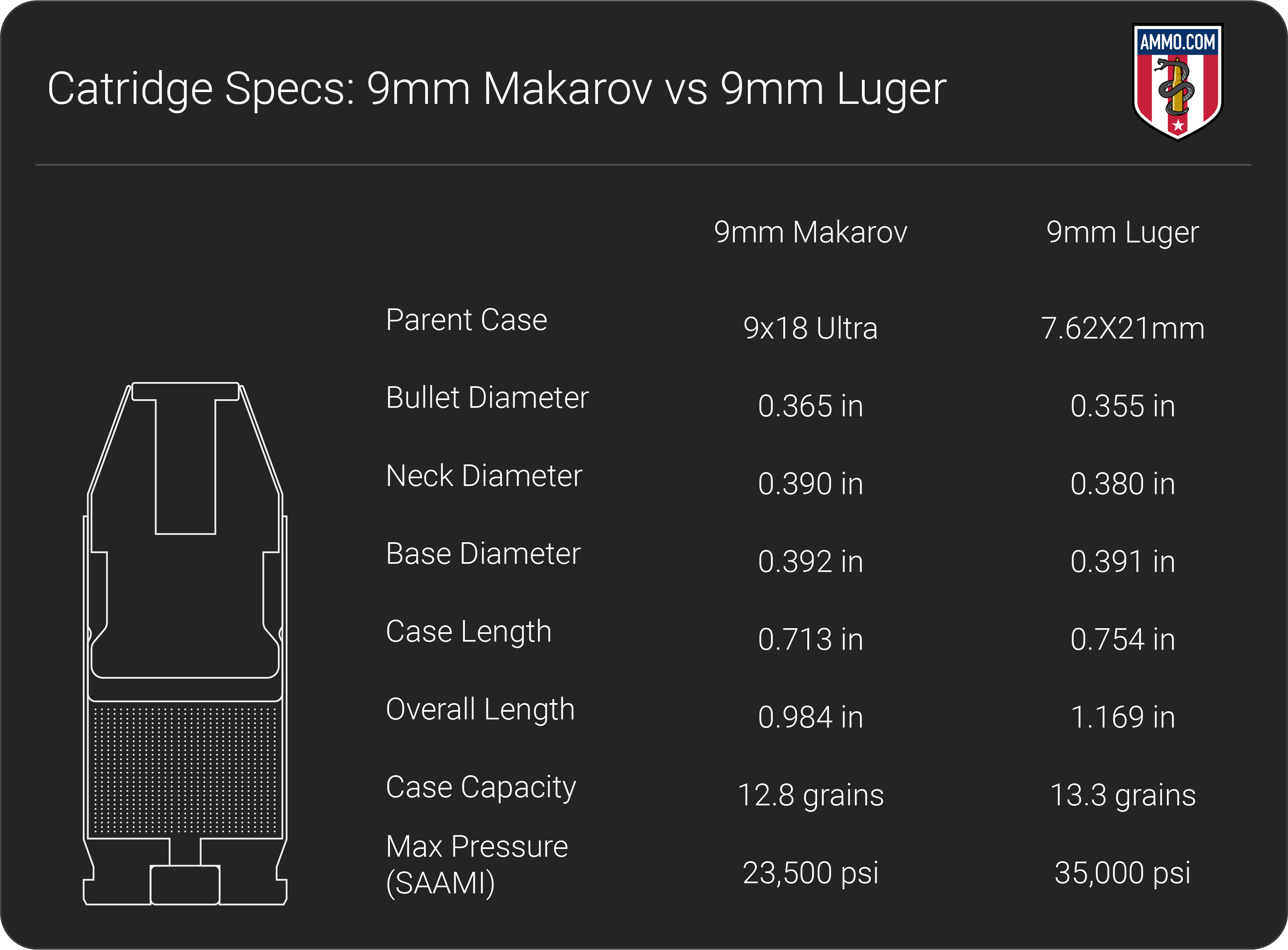
In 1903, Georg Luger presented the 9mm Parabellum to the US military for consideration at the Springfield Arsenal and was in competition with John Moses Browning and the 45 ACP. The 9mm was not adopted by the US military until much later and was instead picked up by the German Imperial Navy and Army in 1904 and 1908, respectively.
In contrast, the 9x18mm Makarov was developed in the early phases of the Cold War to replace the 7.62x25mm Tokarev and its accompanying TT-35 pistol. This handgun had a bad tendency to have its magazine drop during firing and the Soviets wanted a direct blowback, fixed-barrel handgun design for accuracy and reliability.
Boris Semin developed the 9mm Makarov pistol cartridge in 1946 off the German Luftwaffe 9x18mm Ultra cartridge as it was more powerful than the 9x17mm (380 ACP) round used in the Walther PP.
In 1947, Nikolay Makarov developed the Makarov PM pistol using the 9x18mm round. In 1951, the Makarov PM handgun and 9x18mm cartridge were accepted by the Soviets and the Makarov name was added to the cartridge name.
Perhaps the biggest difference between the 9x18mm Makarov and the 9mm Luger is the bullet diameter each pistol cartridge fires. Although both rounds carry the 9mm designation, the 9mm Luger fires a 0.355” diameter bullet while the Russian Makarov round fires a larger diameter bullet at 0.365”.
The reason for the difference is due to the Russians using an older method for measuring bore diameter, which is to measure the distance across the lands of the rifling. American and NATO cartridge regulatory agencies uses the newer method, which is to measure across the grooves. Therefore, the Russian ammunition requires a slightly wider bullet.
There are some who theorize that the former Soviet Union did this on purpose to prevent potential enemies (primarily the Germans at that point in time) from using their ammo in Russian firearms.
As the 9mm Luger case length is 19.15mm or 0.754” it will not fit into the chamber of a Makarov pistol since the case length is measured at 18.10mm or 0.713”. Furthermore, if it were even possible to close the chamber of a 9mm Mak pistol on a Luger round (it’s not possible), the bullet would not engage the rifling properly and would be horribly inaccurate.
The overall length of the 9mm Luger is also larger than the Makarov round, measuring 1.169” vs 0.984” respectively.
In terms of bullet weight, the 9mm Luger typically fires 115, 124, and 147 grain bullets while the 9mm Makarov is typically loaded with 95 grain bullets.
With a longer case, the 9mm Luger has a higher case capacity than the 9x18mm Makarov. The case capacity for the Luger is measured at 13.3 gr compared to 12.8 gr for the Makarov.
As such, the maximum pressure for the 9mm Luger is considerably higher at 35,000 psi per SAAMI specs compared to 23,500 psi for the 9mm Makarov.
This difference is an excellent example of the handgun design considerations for both pistol cartridges. The 9mm Makarov was specifically designed for a blowback recoil system and is considered by many shooters as the most powerful cartridge to use in this design.
On the other hand, your typical 9mm pistol like a Glock 17 or Sig Sauer P320 uses a locked breech design that can handle higher pressures.
Recoil
Recoil is an important consideration when purchasing a new handgun as a round with heavy recoil will be more difficult to control and will slow your rate of follow up shots. The potential for flinching is also an issue for cartridges with heavy recoil.
Felt recoil will differ from shooter to shooter and is often dependent on firearm choice, stance, and your chosen factory ammo or handloads. However, free recoil is a more objective measure of how hard a cartridge hits based on firearm weight, muzzle velocity, powder charge, and bullet weight.
Both 9mm rounds are known for having incredibly low recoil, however the 9mm Makarov will have slightly less free recoil.
For this comparison we will compare two popular practice loads for each cartridge. For the 9mm Luger we will consider the Winchester white box 115 gr full metal jacket (FMJ) factory load traveling at 1,190 fps and Fiocchi 95 gr FMJ’s traveling at 1,020 fps for the 9x18mm Makarov.
The handguns selected for this comparison will be the Glock 45 weighing 2 lbs loaded and the Makarov PM weighing 1.5 lbs.
Given these criteria, the 9mm Luger will have a free recoil of 4 ft-lbs compared to 3 ft-lbs for the 9mm Makarov.
Clearly the 9mm Makarov has lower free recoil, but many shooters report the Makarov as having more felt recoil than the 9mm Luger. Why is that?
Although the Makarov round has less free recoil, it is the pistol design itself that causes this difference in felt recoil.
A blowback pistol is extremely economical and simple to manufacture, however the recoil spring is the only thing holding the barrel in battery. As such, when the weapon is fired, the recoil spring is the only mechanism that is available to mitigate recoil. Therefore, all the recoil is sent back towards the shooter, creating the perception that the Makarov has higher recoil.
In contrast, the 9mm Luger (although capable of being used in a blowback recoil system) is typically only chambered in locked breech designs. This design allows for recoil mitigation systems to be implemented and creates the perception that the 9mm Luger has less felt recoil.
Muzzle Velocity, Kinetic Energy, and Trajectory
Thanks to its higher case capacity, the 9mm Luger is superior to the 9mm Makarov in every ballistic category.
To validate this thesis, we will compare two different factory loads from each cartridge and analyze their ballistic performance.
For 9mm Makarov ammunition we will consider the Fiocchi 95 gr FMJ and Hornady Critical Defense 95 gr FTX jacketed hollow point (JHP). For 9x19mm Parabellum we will consider the Winchester 115 gr FMJ and Sig Sauer V-Crown 124 gr JHP self-defense ammo.
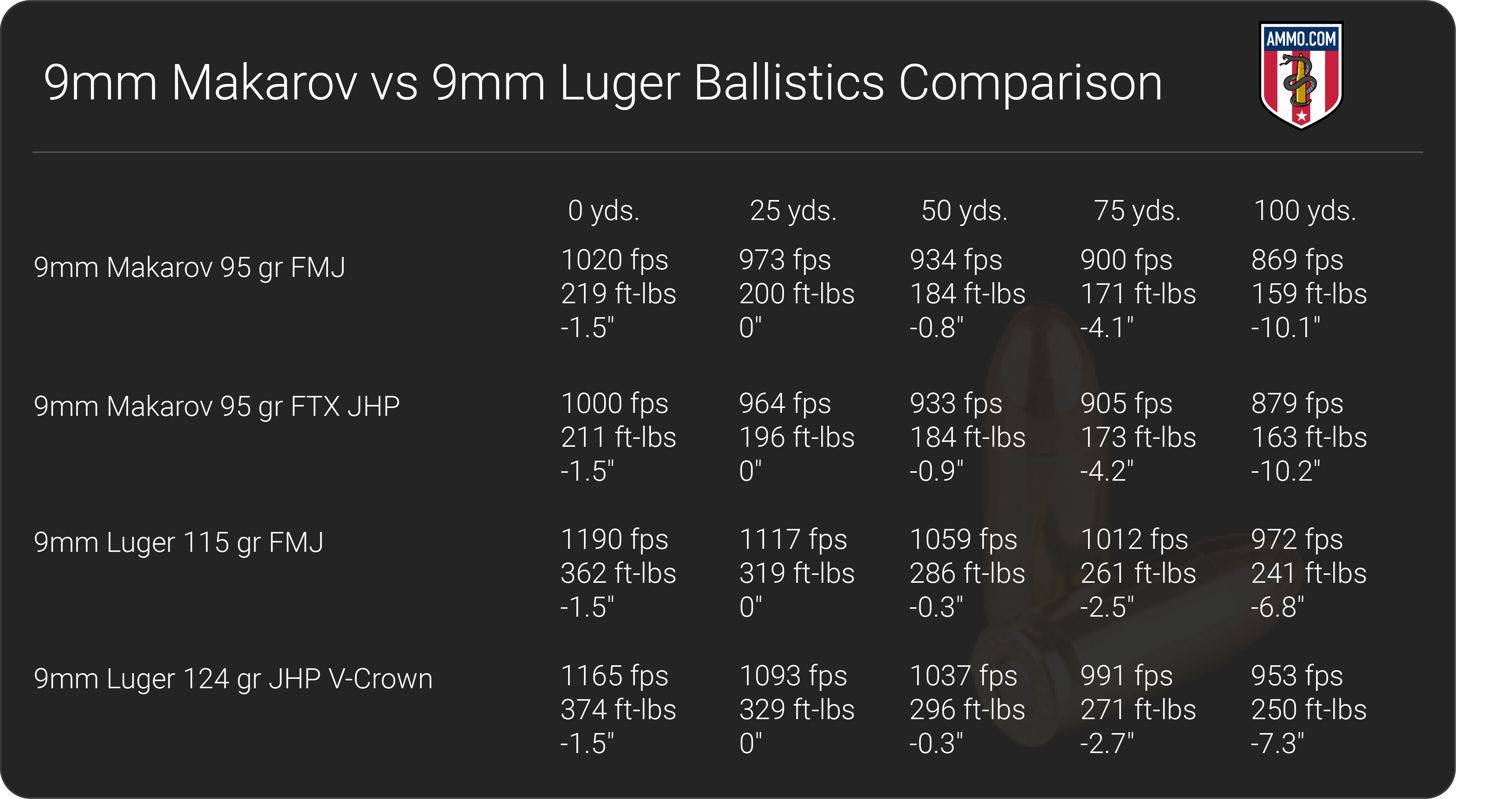
Looking at the ballistics, it’s pretty clear that the increased case capacity of the 9mm Luger pays dividends downrange.
In terms of muzzle velocity, the 9x19mm Luger loads are over 150 fps faster than both Makarov rounds. The 115 gr FMJ had the highest muzzle velocity at 1,190 fps while both Makarov factory loads are about 1,000 fps at the muzzle while firing lighter bullets.
Kinetic energy totals for 9mm Luger was about 150 ft-lbs higher when compared to 9mm Makarov. The 124 gr JHP V-Crown Sig Sauer load had the highest muzzle energy at 374 ft-lbs while both Makarov loads averaged around 200 ft-lbs.
In terms of trajectory, the 9mm Luger has approximately 30% less bullet drop than the 9mm Makarov at 100 yards thanks to the Luger’s higher velocity. Both Luger loads had an average of -7” of bullet drop compared to an average of -10” for the Makarov at 100 yards.
To put it simply, the 9x19mm Parabellum is a more powerful round and superior to the 9mm Makarov in all ballistic categories.
Magazine Capacity
This is another category where the 9mm Luger dominates, as most 9x19mm pistols utilize double-stacked magazines while the Makarov pistols use single-stack magazines.
This comparison really showcases how firearms technology has advanced since the Cold War.
Most Makarov pistols on the market these days are older Cold War era handguns like the Hungarian FEG PA-63 imported by Century Arms. This is a stereotypical 9mm Makarov handgun and has a single-stack magazine that carries 7 rounds.
Compare that to a standard Glock 17 that carries 17-rounds of 9mm Luger which uses a double-stacked mag.
One criticism that could be levied is that the Glock 17 is considerably larger than a standard Makarov handgun. However, if we consider the Glock 26, which uses a subcompact frame and has a 10-round capacity, the 9mm Luger still comes out on top.
Concealed Carry/Self-Defense
There are advantages and disadvantages to both 9mm cartridges when it comes to self-defense, however most shooters will opt for the 9mm Luger.
One positive aspect of the Makarov pistol is its fixed barrel. This will often provide slight improvements in accuracy as there are fewer moving parts in the handgun. It should also be noted that Makarov handguns use single stack magazines, meaning they have thinner grips that make them easier and more comfortable for concealed carry.
However, the 9mm Luger has some major benefits that cannot be ignored, namely better ballistics, higher magazine capacity, and lower felt recoil. Furthermore, the 9mm Luger is perhaps one of the most researched and developed handgun cartridges on the planet, meaning that self-defense hollow points have been thoroughly optimized.
Handgun manufacturers have also worked on providing concealed carry permit holders a wide variety of pistols to choose from in 9mm Parabellum. From micro-subcompact single stacks to full-sized Colt 1911’s to the new Sig Sauer P320, the sky is the limit for the modern responsible gun owner for the 9mm Luger.
Although there is nothing inherently wrong using a 9mm Mak as your CCW handgun, the 9mm Luger simply makes more sense for most shooters as it delivers more kinetic energy to the target with less felt recoil.
Ammo and Handgun Cost/Availability
As the top selling centerfire handgun cartridge on the planet, the 9x19mm Luger has considerably more ammo and handgun options available to it.
In terms of ammo variety, the 9mm Luger offers shooters a wide array of shooting options. From subsonic ammo for use with a suppressor to inexpensive full metal jacket loads to expanding self-defense hollow points, the 9mm Luger has it all.
Finding 9mm Luger ammo is incredibly simple, as every range, sporting goods store, and gun shop will have ample supplies of 9mm available for all your shooting needs.
On the other hand, finding Makarov ammunition is often a bit of a task for most shooters. Although Makarov ammo never saw massive commercial success like the Luger, ammo availability for 9mm Makarov has been hamstrung thanks to the Russian ammo import ban put into place in September of 2021 by the Biden administration.
Although there are a few ammo manufactures who produce Makarov ammo, it pales in comparison to the near 30:1 advantage the 9mm NATO has over the Soviet cartridge.
In terms of price, the 9mm Luger is considerably less expensive to shoot thanks to its adoption by the U.S. military, NATO, and numerous law enforcement agencies across North America and Europe. On average, inexpensive FMJ practice ammo will go for around $0.40/round while self-defense JHP ammo typically runs around $1/round for 9mm Luger.
One great aspect of the 9mm Luger is that it is so inexpensive to shoot, meaning you can spend the whole day at the range and not break the bank. A good way to keep your cost per round low is to order 9mm bulk ammo and always ensure your range bag is chalk full of 9mm vs buying it at a premium when you go shooting.
In contrast, 9mm Makarov FMJ ammo starts around $0.60/round while hollow points can go for upwards of $2/round if you can find them.
Speaking of overall price per round, buying in bulk is always smart! Make sure to check out our stock of Hornady 9mm ammo for the best deals.
If you want to purchase a 9mm Luger pistol you are in luck, because virtually every handgun manufacturer in North America has at least one offering in 9mm Luger. Glock, Smith & Wesson, Springfield, Sig Sauer, Ruger, Kimber, and Kel-Tec are just a few of the handgun producers who have a wide array of 9mm handguns available to meet your shooting needs.
On the other hand, there are currently no manufactures making handguns chambered in 9x18 in North America at the time of writing. This means that your only options are surplus handguns imported from former Communist Bloc countries.
Reloading
Reloading is one method shooters use to reduce their overall cost per round and increase the consistency and accuracy of their ammo. Furthermore, handloads can be tailored to your 9mm pistol to meet your specific shooting needs.
Reloading for 9mm Luger is a great way to get familiar with the process of handloading for a minimal overall cost. In terms of components, 0.355” diameter bullets are relatively easy to come by as they are used for other rounds like the 357 SIG which is a semi-auto adaptation of the 357 Magnum.
Reloading your 9x18mm brass is also a good way to circumvent the relative lack of Makarov ammo availability as pistol cases can last for numerous reloading cycles. Sourcing the wider 0.364” diameter Makarov bullets can be an issue, however companies like Berry’s and Speer make bullets specific for the 9x18mm.
Keeping your Makarov brass separated from your Luger brass is a major issue to consider. I recommend not only segregating your brass but inspecting your cases prior to doing a reloading session.
I can’t recall how many times I’ve found Makarov or 380 Auto brass mixed in with my 9mm Luger brass and accidentally ran it through the press. If this happens, you’ll fell a distinct difference in pressure when you flair the case mouth or seat the bullet (not that I’ve ever done that!)
Sourcing factory new Makarov brass can be an issue as Starline is one of the few companies who currently offers it.
On the other hand, finding 9mm Luger brass is ridiculously easy as it is littered across the ground at virtually every indoor and outdoor shooting range. Just be courteous and ask shooters around you if it is ok to pickup their brass before you start increasing your 9mm stockpiles on their dime.
Final Shots: 9mm Luger vs 9mm Makarov
The 9mm Makarov and 9mm Luger are two excellent handgun cartridge options for concealed carry and home defense.
The 9x19mm Luger is the most popular centerfire handgun cartridge in the world bar none. Ammo is inexpensive, plentiful, and handguns are available in all shapes, sizes, and configurations to meet your shooting needs.
The 9x18mm Makarov is a Soviet-era cartridge that is still in use today in several Eastern European countries as well in the Russian Federation. Makarov ammo was designed for use in a blowback handgun design which offers exceptional accuracy and relative low cost of production compared to other 9mm pistols.
Although the 9mm Makarov can be slightly more accurate, it should come as no surprise that our pick is the 9mm Luger. With so much ammo availability and the effectiveness of modern 9mm JHP ammo so readily available, it’s hard not to pick the Luger over the Makarov for most shooters.
However, if you own an older Makarov pistol, there’s no need to get rid of it as it will be a fine shooter for you for many years to come. However, I’d not go out of my way to pick one up unless you are a collector or prefer shooting more expensive and hard-to-find ammo.
No matter which cartridge you choose, make sure you stock up on ammunition here at Ammo.com and I’ll see you on the range!
Ammo Comparisons
- .308 vs 5.56
- 6.5 Creedmoor vs .308
- .300 Blackout vs .308
- .300 Win Mag vs .308
- .243 vs .308
- .308 vs .30-06
- 7mm-08 vs .308
- .270 vs .308
- 7.62x39 vs .308
- .223 vs .308
- .338 Lapua vs .308
- .380 ACP vs 9mm
- .223 vs 5.56
- .300 Blackout vs 5.56
- 9mm vs 45 ACP
- 9mm vs 40 S&W
- .357 SIG vs 9mm
- 10mm vs 9mm
- 9mm vs 9mm Luger
- .243 vs .270
- .300 Win Mag vs .30-06
- .270 vs .30-06
- .40 vs .45
- 38 Special vs 357
- 9mm vs 40 vs 45
- 5.56 vs 7.62x39
- 338 Lapua vs .30-06
- .30-30 vs .30-06
- 300 PRC vs 338 Lapua
- .30-06 vs 7mm
- 300 Win Mag vs 338 Lapua
- 300 PRC vs 300 Win Mag
- 300 WSM vs 300 Win Mag
- 338 Win Mag vs 338 Lapua
- 12 Gauge vs 20 Gauge
- 10mm vs 357 Mag
- .30-30 vs 7.62x39
- 224 Valkyrie vs 22-250
- 17 HMR vs 22 Mag
- 7.62x39 vs .300 Blackout
- 45 ACP vs 45 Auto
- 45-70 vs 30-30
- 300 Blackout vs 223
- 357 Magnum vs 9mm
- 350 Legend vs 300 Blackout
- 224 Valkyrie vs 223
- 45 ACP vs 38 Super
- 6.5 Grendel vs .308
- 17 HMR vs 22 LR
- 10 Gauge vs 12 Gauge
- 22-250 vs 223
- 45 Colt vs 45 ACP
- 350 Legend vs 30-30
- 5.7x28 vs 223
- 5.7 vs 9mm
- 5.56 vs 5.7
- 22 vs 9mm
- Buckshot vs Birdshot
- 450 Bushmaster vs 308
- 450 Bushmaster vs 223
- Buckshot vs Slug
- 6.5 Grendel vs 5.56 vs 223
- 6mm ARC vs 6.5 Grendel
- 44 vs 45
- 458 SOCOM vs 5.56
- 357 vs 44
- 32 ACP vs 380
- 300 Win Mag vs 338 Win Mag vs 338 Lapua Mag
- 450 Bushmaster vs 458 SOCOM vs 50 Beowulf
- 6mm Creedmoor vs 6.5 Creedmoor
- TMJ vs FMJ
- 44 Special Vs 44 Magnum
- 45 90 vs 45 70
- 6.8 Western vs 6.8 SPC
- 50 Beowulf vs 50 BMG
- 26 Nosler vs 6.5 PRC
- 28 Gauge vs 410
- 6.8 SPC vs 5.56
- 6.8 SPC vs 6.5 Grendel
- 6.8 Western vs 7mm Rem Mag vs .28 Nosler
- 6.8 Western vs 6.5 Creedmoor
- 22 Hornet vs 223
- 6.8 Western vs 6.5 PRC
- .410 vs 12 Gauge
- .410 vs 20 Gauge
- 22 LR vs 22 Mag
- 6mm ARC vs 243
- 7mm-08 vs 270
- 243 vs 6.5 Creedmoor
- Nickel vs Brass Casing
- 204 Ruger vs 223
- 50 Beowulf vs 5.56
- 260 Remington vs 6.5 Creedmoor
- 6mm Remington vs 243
- 28 Nosler vs 300 PRC
- 50 Beowulf vs 50 AE
- 22 Nosler vs 22-250
- 450 Marlin vs 45-70
- 300 Win Mag vs 300 Norma
- 458 SOCOM vs 300 Blackout
- 38-55 vs 45-70
- 22 Hornet vs 22 LR
- 300 Norma vs 338 Lapua
- 338 Lapua vs 50 BMG
- 28 Nosler vs 300 Win Mag
- 28 Nosler vs 6.5 Creedmoor
- 204 vs 22-250
- 458 SOCOM vs 45 70
- 44 40 vs 45 70
- 6.8 SPC vs 6.5 Creedmoor
- 450 Bushmaster vs 30-06
- 7mm Rem Mag vs 300 Win Mag
- 30 Carbine vs 223
- 25-06 vs 30-06
- 26 Nosler vs 28 Nosler
- 16ga vs 12ga
- 30 06 vs 7.62 x54R
- 9mm Makarov vs 9mm Luger
- 350 Legend vs 223
- 30 Carbine vs 5.56
- 6.5x55 vs 6.5 Creedmoor
- 6.5 Creedmoor vs 270 vs 25-06
- M193 vs M855
- 450 Bushmaster vs 458 SOCOM
- 6.5 Grendel vs 6.5 Creedmoor
- 350 Legend vs 5.56
- .277 Fury vs 6.8 SPC
- 277 Fury vs 300 Win Mag
- 10mm vs .45 ACP
- 277 Fury vs 223
- 6.8 SPC vs 300 Blackout
- 6.5 PRC vs 6.5 Creedmoor
- 277 Fury vs 308
- 277 Fury vs 6.5 Creedmoor
- 350 Legend vs 450 Bushmaster
- 277 Fury Vs 5.56 NATO
- 10mm vs 40S&W
- 32 ACP vs 9mm
- 32 Special vs 9mm
- 8.6 Blackout vs 300 Blackout
- 30 Super Carry vs. 9mm
- 5.56 vs 9mm
- .50 Action Express vs 9mm
- 7.62x25 vs. 9mm
- 10mm vs 44 Magnum
- 300 Blackout vs 300 Win Mag
- 6.5 Grendel vs 300 Blackout
- 460 Rowland vs 10mm
- 300 RUM vs 300 PRC
- 300 Norma vs 300 PRC
- 45 GAP vs 45 ACP
- 7mm PRC vs 300 Win Mag
- 300 PRC vs 6.5 Creedmoor
- 300 PRC vs 308
- 357 SIG vs 357 Mag
- 7.62x39 vs 7.62x51
